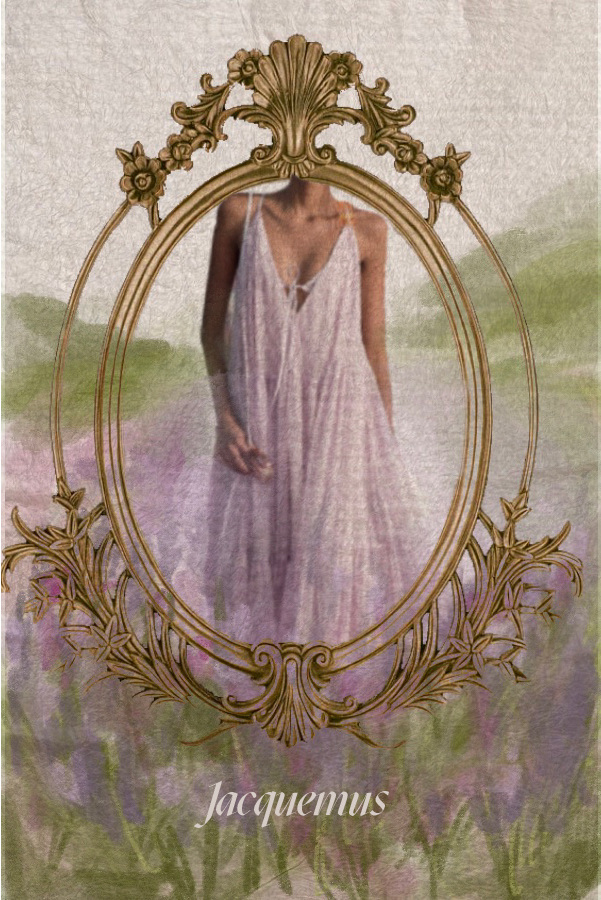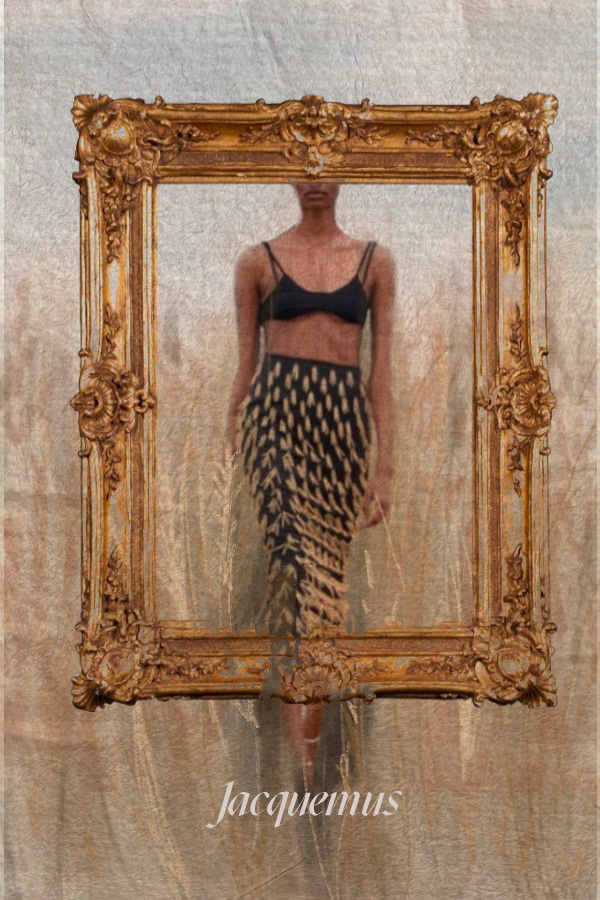Haute Couture et Flore
By Bryn Palmer
October 24, 2022

Graphic by Megan Gallegos
Jacquemus is the love child of fashion and nature.
Simon Porte Jacquemus is known for his Instagram-worthy designs. His staples like the “Le Chiquito” mini bag and the huge “Le Grand Chapeau Bomba” hat have lived on my explore page for months. His runway shows are not exclusive to IG fame either, as his collections presented in both lavender and wheat fields have taken over my feed as well. Other designers have tried, but none have quite yet mastered the art of merging fashion with nature — so how is Jacquemus so good at it?
Jacquemus’ brand centers around youth and playfulness. Fun ruching, playing with geometry, and impractically-sized accessories all exhibit these themes. His early shows were presented indoors like traditional fashion shows, but the brand really began to take off once it went beyond the bounds of four walls.
Men’s Le Gadjo SS19

Photo from: Men’s Fashion Post
Jacquemus’ debut men’s collection was also his first outdoor show. Unlike other shows of this nature, the cohesion between clothing and the show’s setting was portrayed in a literal sense. Previous exhibits of his collections had a more industrial feel as they were confined by the perimeter of a dark room with a central spotlight on a runway. No longer bound by the traditional realms of the Parisian fashion scene, Jacquemus allowed his creative potential to soar. Rather than just sending models down a bare runway, he married the clothes with their surroundings to craft a unique and persistent brand image.
The clothes worked with the environment because, well, they would be worn there. It was apparent that the beach setting had some influence on the color palette for this collection. The beige tones resembled sand on the beach, the blue hues were reminiscent of the sky and ocean water, the reds referenced lifeguards, and the yellows and oranges coincided with the shade of the sun. Jacquemus established himself as a mastermind because he not only developed a collection, but he invented an archetype to pair with it. He created the gadjo archetype, which, as seen through the models, is basically a Mediterranean jock. Jacquemus himself said when creating this collection that he did not think there were Mediterranean men on the market with “a solar energy like this.” If there was not one before, there definitely are some now, as he has given new life to it.
“Le Coup De Soleil” SS20

Photo from: Les Facons
Jacquemus’ second date with nature took place in 2019 when he debuted his SS2020 collection entitled “Le Coup De Soleil.” Translating to “sunburn” in English, the collection celebrated the label’s tenth anniversary in a beautiful lavender field in Provence, France. Stretched out across the field was a sassy hot pink runway for the models to strut down. In a sense, it served as a nostalgic tenth birthday party. Similar to most of his other outdoor shows, the cohesive relationship between the clothing and the setting came from Jacquemus’ personal connections. The lavender field was not far from his childhood home in Provence, France. I can imagine a young Jacquemus frolicking in these fields with his sister.
Connecting to the brand’s themes, the floral patterns, flowy dresses, large hats, and colorful, oversized blazers only added to the fun. The brand’s ideals of youth and playfulness aligned with the symbolism associated with lavender. Traditionally, lavender symbolizes calmness, grace, and devotion. Connecting to the brand’s themes, these two make for an excellent combination.
The color palette featured an array of fuschia, pastel greens, blues, yellows, and oranges. The pastels of the clothing paired with the soft purple shade of the lavenders surrounding the models made for a beautiful sight. The collection was the true epitome of spring fashion.
“L’Amour” SS21

Photo from Vogue
Jacquemus’ next collaboration with nature occurred in a gorgeous wheat field in the French countryside. Again, he drew inspiration from his upbringing as he grew up in a family of farmers. The collection had several plaid, checkered, and floral prints, all of which are synonymous with a rural setting. Furthermore, there were bags shaped like plates and tablecloths on clothing that resembled the fruitfulness of farming. As a child, my closet primarily consisted of plaid and floral patterns, so seeing them in adult clothing imbued a nostalgic feeling within me. He kept the youthfulness of the pattern at its core while adapting it for his young adult audience.
The gowns in the show looked ethereal amongst the fields, and it seemed as though there was nowhere else for the model to be but there. Here is where I started to see how Jacquemus successfully married nature with fashion. This show made me believe that he used the setting as his muse. Firstly, the color palette resembled the exact scene. The beiges of wheat, blues of the sky, greens of the grass, and whites of the clouds were all present in the clothing. The movement of the clothing replicated the way that the wheat moved in the wind. The tassels on look 42 even looked like wheat themselves.
Many of the looks were marked with cut-out hearts, while other pieces resembled modern wedding dresses. The looming theme of love further connected to the wheat fields. Wheat symbolizes bounty and fertility, which are two aspects of romance.
“Le Papier” Fall22

Photo from Hello Magazine
Though this collection was made in collaboration with Nike, it still stuck to Jacquemus’ brand at its core. The scene was like that of a dystopian film. The looks in this collection were primarily neutral, with the exception of some burnt orange, navy green, and sky blue looks. Their silhouettes and styling provided somewhat of a dystopian feel, reinforced through its location in the Camargue salt marshes in France. The marshes consist of mounds of sand stretching for miles. Its Siberian vibe looks as if someone created an arctic spinoff of the movie Dune.
So, let’s go back to the original question.
Jacquemus is a master at merging fashion and nature because he draws from his upbringing to extract elements of the setting and connect them to his vision. Like we saw with “L’Amour,” he set the show in a wheat field because his family is full of farmers, and he then connected the wheat to the designs by crafting plates, tablecloths, and floral patterns. Jacquemus’ use of various locations around France sets him apart from other designers by straying from the typical Parisian style of displaying flashy clothes in metropolitan areas. He said, “I always want to be the voice that says there is something other than Paris,” he goes on. “I live in Paris, my studio is in Paris, and my full team is in Paris. I love it, but it’s also important to send another positive message that you can be from somewhere else.”
I love Jacquemus’ collections, and I cannot wait to see his creative light continue to shine in the future. ■

Graphic by Megan Gallegos
Other Stories in Fashion
© 2024 SPARK. All Rights Reserved.
